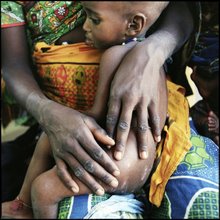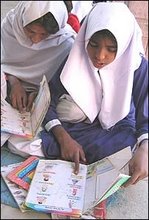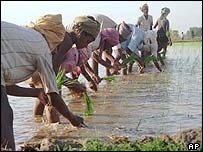PREAMBLE: Diarrhoea remains the second leading cause of death among children under five globally, surpassed only by pneumonia, the most common cause. Nearly one in five child deaths – about 1.5 million each year – is due to diarrhoea. It kills more young children than AIDS, malaria and measles combined.
PacificSci wishes to draw attention to a recently released joint report from UNICEF and WHO that addresses this perennial global pandemic. Diarrhoeal disease, no longer a scourge in developed countries, attracts comparatively little attention from the international donor community, when compared with conditions such as HIV/AIDS, TB and malaria. And today, the media spotlight has shifted to H1N1 influenza, with little sense of proportionality in terms of continuing real disease burdens globally.
Acknowledgement: The material used in this edition of Global Perspectives is drawn almost verbatim from the Executive Summary of the joint UNICEF/WHO report, as referenced below.
THE REPORT:
In 2006, the United Nations Children’s Fund (UNICEF) and the World Health Organization (WHO) issued a report highlighting the most common cause of death among children (Pneumonia: The Forgotten Killer of Children). The purpose was to raise the profile of that neglected disease. This new report is written with the same intent – to focus attention on the prevention and management of diarrhoeal diseases as central to improving child survival. Together, pneumonia and diarrhoea are responsible for an estimated 40 per cent of all child deaths around the world each year.
There are lessons to be learned from past experience. An international commitment to tackle childhood diarrhoea in the 1970s and 1980s resulted in a major reduction in child deaths. This came about largely through the scaling up of oral rehydration therapy, coupled with programmes to educate caregivers on its appropriate use. But these efforts lost momentum as the world turned its attention to other global emergencies. Today, only 39 per cent of children with diarrhoea in developing countries receive the recommended treatment, and limited trend data suggest that there has been little progress since 2000.
This report examines the latest available information on the burden and distribution of childhood diarrhoea. It also analyses how well countries are doing in making available key interventions proven to reduce its toll. Most importantly, it lays out a new strategy for diarrhoea control, one that is based on interventions drawn from different sectors that have demonstrated potential to save children’s lives. It sets out a 7-point plan that includes a treatment package to reduce childhood diarrhoea deaths, as well as a prevention package to make a lasting reduction in the diarrhoea burden in the medium to long term.
New aspects of this approach include vaccinations for rotavirus, which is estimated to cause about 40 per cent of hospital admissions due to diarrhea among children under five worldwide.3 In terms of community-wide sanitation, new approaches to increase demand to stop open defecation have proven more effective than previous strategies. It has been estimated that 88 per cent of diarrhoeal deaths worldwide are attributable to unsafe water, inadequate sanitation and poor hygiene.
Actions needed to take interventions to scale
In many countries, progress has been made in the delivery or promotion of several of these interventions, particularly vitamin A supplementation and exclusive breastfeeding. However, a substantial reduction in the diarrhoea burden will require greater emphasis on the following actions:
■ Ensure wide availability of low-osmolarity ORS and zinc, which could have a profound impact on child deaths from diarrhoea if scaled up immediately. Possible strategies to increase their uptake and availability could include the development of smaller ORS packets and flavoured formulas, as well as delivering zinc and low-osmolarity ORS together in diarrhoea treatment kits.
■ Include rotavirus vaccine in national immunization programmes worldwide, which was recently recommended by the World Health Organization.
A 7-point plan for comprehensive diarrhoea control is outlined immediately below: two (#1 and #2) elements are contained with a treatment package”, while five (#3 to #7) are contained within a prevention package.
Treatment Package
The treatment package focuses on two main elements, as outlined in a 2004 joint statement from UNICEF and WHO: 1) fluid replacement to prevent dehydration and 2) zinc treatment. Oral rehydration therapy – which has been heralded as one of the most important medical advances of the 20th century – is the cornerstone of fluid replacement.
New aspects of this approach include low-osmolarity oral rehydration salts (ORS), which are more effective at replacing fluids than the original ORS formulation, and zinc treatment, which decreases diarrhea severity and duration. Important additional components of the package are continued feeding, including breastfeeding, during diarrhoea episodes and the use of appropriate fluids available in the home if ORS are not available, along with increased fluids in general.
Prevention Package
The prevention package highlights five main elements that require a concerted approach in their implementation. The package includes: 3) rotavirus and measles vaccinations, 4) promotion of early and exclusive breastfeeding and vitamin A supplementation, 5) promotion of handwashing with soap, 6) improved water supply quantity and quality, including treatment and safe storage of household water, and 7) community-wide sanitation promotion.
Key strategic elements include:■ Develop and implement behaviour change interventions, such as face-to-face counselling, to encourage exclusive breastfeeding.
■ Ensure sustained high levels of vitamin A supplementation, such as by combining its delivery, where effective, with other high-impact health and nutrition interventions.
■ Apply results of existing consumer research on how to motivate people to wash their hands with soap to increase this beneficial and cost-effective health practice. Handwashing with soap has been shown to reduce the incidence of diarrhoeal disease by over 40 per cent.
■ Adopt household water treatment and safe storage systems, such as chlorination and
filtration, in both development and emergency situations to support reductions in the number of diarrhoea cases.
■ Implement approaches that increase demand to stop community-wide open defecation. As with handwashing, the new approach employs behavioural triggers, such as pride, shame and disgust, to motivate action, and leads to greater ownership and sustainability of programmes.
The report states: “We know what works to immediately reduce deaths from childhood diarrhoea. We also know what actions will make a lasting contribution to reducing the toll of diarrhoeal diseases for years to come. But strengthened efforts on both fronts must begin right away.”
The following actions are needed to take the 7-point plan to scale:
■ Mobilize and allocate resources for diarrhea control.
■ Reinstate diarrhoea prevention and treatment as a cornerstone of community-based primary health care.
■ Ensure that low-osmolarity ORS and zinc are adopted as policy in all countries.
■ Reach every child with effective interventions.
■ Accelerate the provision of basic water and sanitation services.
■ Use innovative strategies to increase the adoption of proven measures against diarrhoea.
■ Change behaviours through community involvement, education and health-promotion activities.
■ Make health systems work to control diarrhoea.
■ Monitor progress at all levels, and make the results count.
■ Make the prevention and treatment of diarrhea everybody’s business.
The Executive Summary to the report concludes with the statement that "There is no better time than now. Political momentum is building to address the leading causes of child deaths, including pneumonia and diarrhoea, to achieve measurable gains in child survival. The year 2008 marked the 30th anniversary of the Alma- Ata Declaration, with reinvigorated calls to focus on primary health care. Lessening the burden of childhood diarrhoea fits squarely with this emphasis, and is essential for achieving Millennium Development Goal 4: reduce child mortality, whose target date is now only six years away."
SOURCE: Executive Summary. Diarrhoea :Why children are still dying and what can be done. The United Nations Children’s Fund (UNICEF)/World Health Organization (WHO), 2009. http://whqlibdoc.who.int/publications/2009/9789241598415_eng.pdf
FROM a Great Canadian and World Statesman
"A great gulf... has... opened between man's material advance and his social and moral progress, a gulf in which he may one day be lost if it is not closed or narrowed..."
Lester B Pearson
http://nobelprize.org/nobel_prizes/peace/laureates/1957/pearson-lecture.html
Thursday, 15 October 2009
DRAWING ATTENTION TO A GLOBAL PANDEMIC - Diarrhoeal Disease
INSPIRATIONAL WELCOME ............................... from T.S.Eliot's "Little Gidding"
If you came this way From the place you would come from... It would be the same at the end of the journey...
If you came, not knowing what you came for, It would be the same... And what you thought you came for Is only a shell, a husk of meaning... From which the purpose breaks only when it is fulfilled If at all.


























